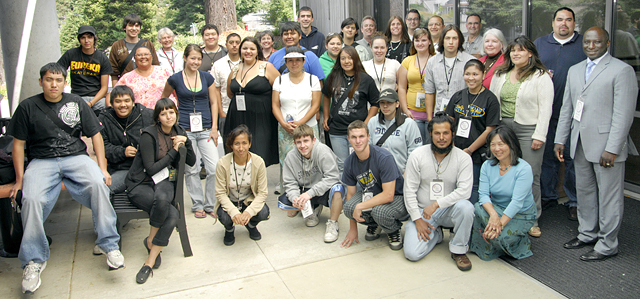
Justin Holz, a transfer student from Golden West College, Huntington Beach, was introduced for the first time this summer to his native Cherokee language through the Coalition for American Indians in Computing (CAIC—pronounced ‘cake’), a summer program hosted by Humboldt State University. Holz is a self-taught computer maven with his own “virtual” online business. He praises CAIC’s merger of cultural study and technological prowess. He plans to major in computer science at HSU.
A CAIC mentor and Humboldt State senior, Marcelino Guel, says, “Regardless of how young you are and how much your life has been influenced by pop culture, you can still retain your own native culture. When I was 11, I was an MTV kid, but our indigenous stories come from an oral tradition and they’re not just stories. They contain historical and moral and ethical values, the precepts you need to govern your life, which you can’t get from technology. But you can pass them on with technology and you can apply the language with computers and keep it vibrant.”
Among other things, this summer’s CAIC students were introduced to an open source software package conceived by Southern Oregon University named ACORNS—Acquisition of Restored Native Speech. The acronym is fitting because the acorn was sacred to the tribes of northern California and southern Oregon.
ACORNS is expressly designed to handle linguistic data. It enables both students and instructors to make and execute files that carry language lessons. “It’s a very well-written program,” Holz says. “I’ve tried to write my own programs, so I know how difficult that can be. It allowed me to begin learning my native [Cherokee] language.”
McKinleyville resident Melitta Jackson, who will be a senior this fall at Arcata High School, likes the fact that ACORNS not only allows Native American students to record their languages, but also to distribute them on Web sites so that others can become acquainted with different linguistic traditions. A former Hoopa student, Jackson is in the arts program at Arcata High. The CAIC Photoshop training she received will give her a head start when she starts fall classes.
Jackson lauds CAIC in broad terms. “I made so many connections, gained a valuable experience and made new friends from all over—mostly the West Coast, but also one girl from Mississippi,” she smiles. Students from New Mexico and Washington state also attended.
One of the program’s guest lecturers is Melodie George-Moore, a veteran K-12 teacher and HSU alum who instructs a high school class in the Hupa language at Klamath-Trinity Joint Unified School District. She sees the practical advantages of cultural preservation for young people who will live the whole of their adult lives in a 21st century that may confront them with new uncertainties. If health care becomes a scarce resource, she suggests, her Native American students may have to recover their tribal knowledge of native plants for medicinal purposes. “Just consider the growing immune resistance to antibiotics,” George-Moore points out. “Through language preservation, students can find native stories about medicinal uses for plants that might have been considered weeds before.”
Funded by the National Science Foundation, CAIC is run by two computer science faculty, Professors Guy-Alain Amoussou and Ann Burroughs. Students explained the high importance they attach to culture and languages, and Amoussou and Burroughs decided to link that interest to information technology. They visited tribal offices to gain first-hand knowledge of how tribal enterprises make use of information technology. They realized that students could pick up a set of skills highly useful in many domains while satisfying their hunger for preserving their heritage.
CAIC is a summer experience for high school and community college students who are not attending Humboldt State. The program’s purpose is to encourage them to consider careers in computing, with an emphasis on cultural integration: retention of cultural identity while working in the information technology field. CAIC introduces them to the academic aspects of the profession: programming, networking, design, graphical information systems and problem solving. The training includes college preparation workshops on financial aid, scholarship applications, study and test-taking skills, stress management and Humboldt State’s Educational Opportunity Program.
Participants receive career planning, including tips about the information technology opportunities available in tribal communities. Youngsters learn the needs of tribal administrators for info-tech professionals.
“We are very interested in getting more students from our local community to participate next year,” Dr. Amoussou said. “We would like to partner with schools, tribal education directors, tribal enterprises and tribal and community leaders.”
CAIC students say they pick up valuable lessons about education from the project. Holz, who has two years of community college behind him and is some years older than his counterparts, found himself taking up the role of informal mentor, teaching while learning. He realized his mother had been right. “My mother is a teacher and she always says, ‘The best way to learn something is to teach it to someone else.’”
Holz underscored the strong interpersonal relationships CAIC fosters. “Through this program you really get an opportunity to know people better than you normally would because you have a common background. There are strengthened friendships here. Going the extra mile to learn about people is a nice thing.”
Guel, the HSU senior whose degree emphasis is American Indian education, echoes Holz’s sentiment. He compares the CAIC class to a miniature United Nations that brings together students from various tribal nations to focus on a common interest, cultural and language preservation via computer. “As a matter of fact,” he muses, “we are all in a way indigenous peoples around the world. Once upon a time, we all at one point had the same fire, drank the same water, resided on the same land and breathed the same air.”